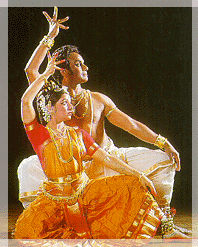Kathakali literally means story-play and is an elaborate dance depicting the victory of truth over falsehood.
A Striking feature of Kathakali is the use of elaborate make-up and colourful costumes. This is to emphasize that the characters are superbeings from another world, and their make-up is easily recognisable to the trained eye as satvik or godlike, rajasik or heroic, and tamasik or demonic.
Mohini Attam

Some poses of Mohini Attam
The theme of Mohini attam dance is love and devotion to god. Vishnu or Krishna is most often the hero. The spectators can feel His invisible presence when the heroine or her maid details dreams and ambitions through circular movements, delicate footsteps and subtle expressions. Through slow and medium tempos, the dancer is able to find adequate space for improvisations and suggestive bhavas or emotions.
The basic dance steps are the Adavus which are of four kinds: Taganam, Jaganam, Dhaganam and Sammisram. These names are derived from the nomenclature called vaittari.
The Mohini attam dancer maintains realistic make-up and adorns a simple costume, in comparison to costumes of other dances, such as Kathakali. The dancer is attired in a beautiful white with gold border Kasavu saree of Kerala, with the distinctive white jasmin flowers around a French bun at the side of her head.
Bharata Natyam from Tamil Nadu.
Bharata Natyam

A typical nritya pose of Bharata Natyam dance with abhinaya.
Bharata Natyam dance has been handed down through the centuries by dance teachers (or gurus) called nattuwanars and the temple dancers, called devadasis. In the sacred environment of the temple these familes developed and propagated their heritage. The training traditionally took around seven years under the direction of the nattuwanar who were scholars and persons of great learning. The four great nattuwanars of Tanjore were known as the Tanjore Quartet and were brothers named Chinnaiah, Ponnaiah, Vadivelu and Shivanandam. The Bharata Natyam repertiore as we know it today was constructed by this talented Tanjore Quartet.
Kuchipudi from Andhra Pradesh
Kuchipudi

Raja and Radha Reddy in a striking pose of Kuchipudi dance.
The dance drama that stil exists today and can most closely be associated with the Sanskrit theatrical tradition is Kuchipudi which is also known asBhagavata Mela Natakam. The actors sing and dance, and the style is a blend of folk and classical. Arguably this is why this technique has greater freedom and fluidity than other dance styles.
Bhagavata mela natakam was always performed as an offering to the temples of either Merratur, Soolamangalam, Oothkadu, Nallur or Theperumanallur.
Odissi from Orissa
Odissi

Gorgeous Odissi pose. Picture courtesy of the Odissi Kala Kendra.
Odissi is based on the popular devotion to Lord Krishna and the verses of the Sanskrit play Geet Govinda are used to depict the love and devotion to God. The Odissi dancers use their head, bust and torso in soft flowing movements to express specific moods and emotions.
The form is curvaceous, concentrating on the tribhang or the division of the body into three parts, head, bust and torso; the mudras and the expressions are similar to those of Bharatnatyam. Odissi performances are replete with lores of the eighth incarnation of Vishnu, Lord Krishna. It is a soft, lyrical classical dance which depicts the ambience of Orissa and the philosophy of its most popular deity, Lord Jagannath, whose temple is in Puri. On the temple walls of Bhubaneshwar, Puri and Konark the dance sculptures of Odissi are clearly visible.
Kathak from Uttar Pradesh
Kathak

The legendary exponent of Kathak, Birju Maharaj.
This north Indian dance form is inextricably bound with classical Hindustani music, and the rhythmic nimbleness of the feet is accompanied by the table or pakhawaj. Traditionally the stories were of Radha and Krishna, in the Natwari style (as it was then called) but the Moghul invasion of North India had a serious impact on the dance. The dance was taken to Muslim courts and thus it became more entertaining and less religious in content. More emphasis was laid on nritta, the pure dance aspect and less on abhinaya (expression and emotion).
Manipuri from Manipur
Manipuri

|





